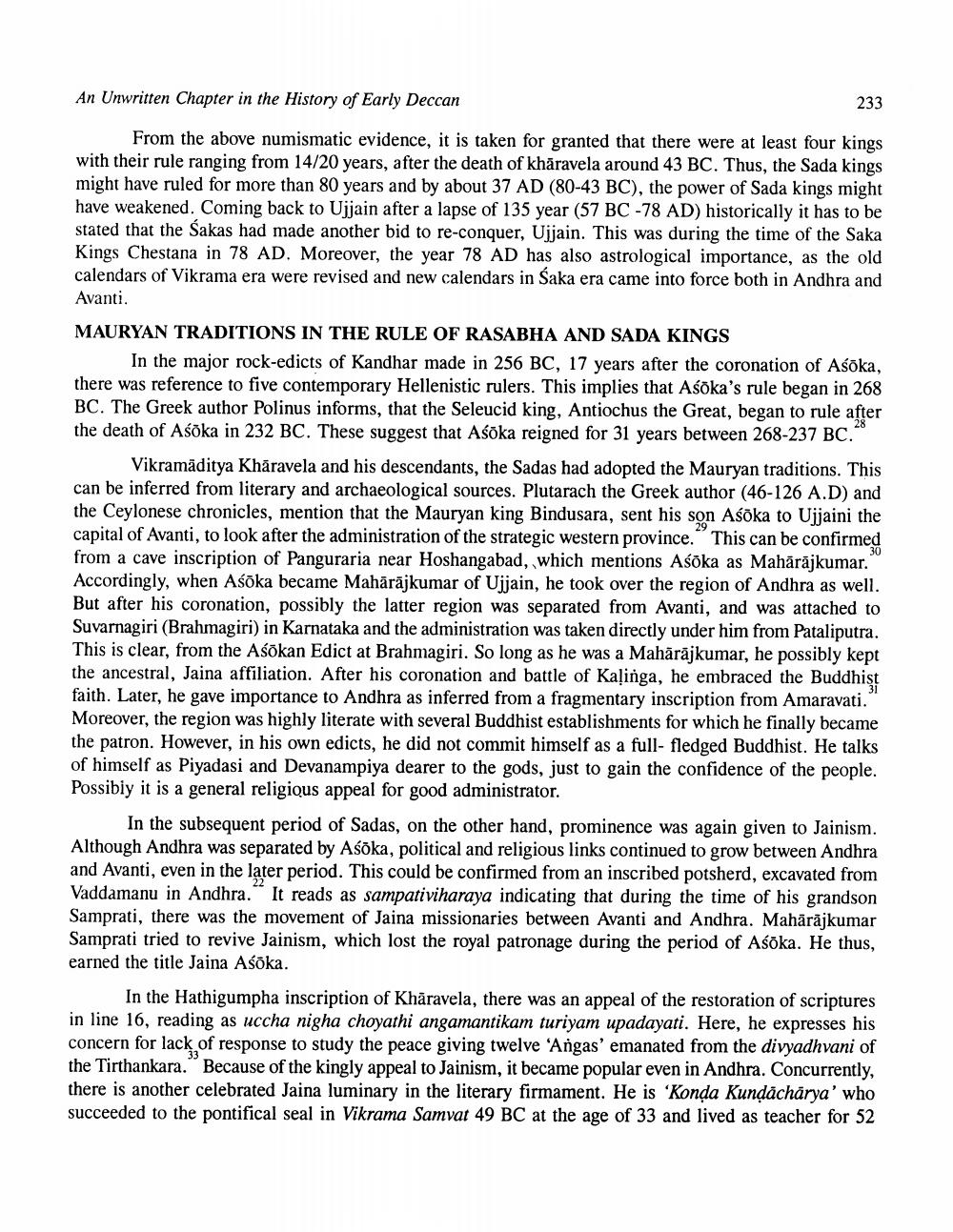________________
An Unwritten Chapter in the History of Early Deccan
233
From the above numismatic evidence, it is taken for granted that there were at least four kings with their rule ranging from 14/20 years, after the death of khāravela around 43 BC. Thus, the Sada kings might have ruled for more than 80 years and by about 37 AD (80-43 BC), the power of Sada kings might have weakened. Coming back to Ujjain after a lapse of 135 year (57 BC-78 AD) historically it has to be stated that the Sakas had made another bid to re-conquer, Ujjain. This was during the time of the Saka Kings Chestana in 78 AD. Moreover, the year 78 AD has also astrological importance, as the old calendars of Vikrama era were revised and new calendars in Saka era came into force both in Andhra and Avanti.
MAURYAN TRADITIONS IN THE RULE OF RASABHA AND SADA KINGS
In the major rock-edicts of Kandhar made in 256 BC, 17 years after the coronation of Asoka, there was reference to five contemporary Hellenistic rulers. This implies that Asoka's rule began in 268 BC. The Greek author Polinus informs, that the Seleucid king, Antiochus the Great, began to rule after the death of Asoka in 232 BC. These suggest that Asoka reigned for 31 years between 268-237 BC.
Vikramāditya Khāravela and his descendants, the Sadas had adopted the Mauryan traditions. This can be inferred from literary and archaeological sources. Plutarach the Greek author (46-126 A.D) and the Ceylonese chronicles, mention that the Mauryan king Bindusara, sent his son Asoka to Ujjaini the capital of Avanti, to look after the administration of the strategic western province. This can be confirmed from a cave inscription of Panguraria near Hoshangabad, which mentions Aśoka as Mahārājkumar. Accordingly, when Aśoka became Mahārājkumar of Ujjain, he took over the region of Andhra as well. But after his coronation, possibly the latter region was separated from Avanti, and was attached to Suvarnagiri (Brahmagiri) in Karnataka and the administration was taken directly under him from Pataliputra. This is clear, from the Asökan Edict at Brahmagiri. So long as he was a Mahārājkumar, he possibly kept the ancestral, Jaina affiliation. After his coronation and battle of Kaļinga, he embraced the Buddhist faith. Later, he gave importance to Andhra as inferred from a fragmentary inscription from Amaravati. Moreover, the region was highly literate with several Buddhist establishments for which he finally became the patron. However, in his own edicts, he did not commit himself as a full-fledged Buddhist. He talks of himself as Piyadasi and Devanampiya dearer to the gods, just to gain the confidence of the people. Possibiy it is a general religious appeal for good administrator.
In the subsequent period of Sadas, on the other hand, prominence was again given to Jainism. Although Andhra was separated by Aśõka, political and religious links continued to grow between Andhra and Avanti, even in the later period. This could be confirmed from an inscribed potsherd, excavated from Vaddamanu in Andhra." It reads as sampativiharaya indicating that during the time of his grandson Samprati, there was the movement of Jaina missionaries between Avanti and Andhra. Mahārājkumar Samprati tried to revive Jainism, which lost the royal patronage during the period of Asoka. He thus, earned the title Jaina Asoka.
In the Hathigumpha inscription of Khāravela, there was an appeal of the restoration of scriptures in line 16, reading as uccha nigha choyathi angamantikam turiyam upadayati. Here, he expresses his concern for lack of response to study the peace giving twelve Angas' emanated from the divyadhvani of the Tirthankara." Because of the kingly appeal to Jainism, it became popular even in Andhra. Concurrently, there is another celebrated Jaina luminary in the literary firmament. He is 'Konda Kundächārya' who succeeded to the pontifical seal in Vikrama Samvat 49 BC at the age of 33 and lived as teacher for 52




